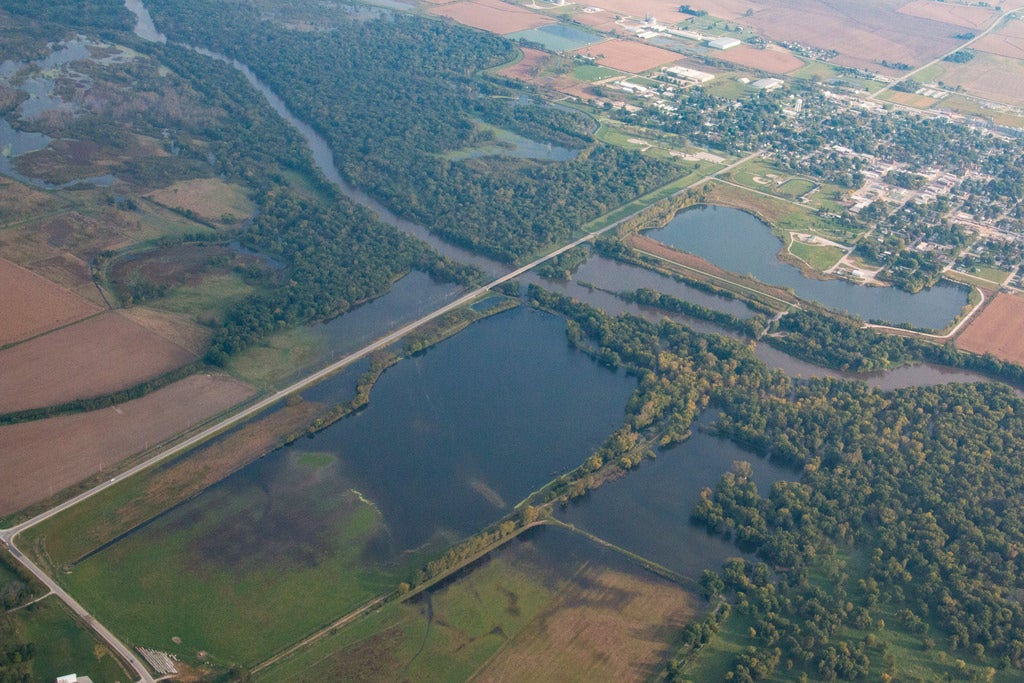I was recently cleaning out old files and came across notes from a presentation I made after the Great Midwest Flood of 1993. It was on the state of the nation’s floodplain management, a topic even more relevant today.
Many no longer recall the Great Midwest Flood despite its record-breaking precipitation, flooding and $13 billion price tag. Sure, 1993 seems like a long time ago, but I believe the reason the flood has left most people’s memory is because, over the last 25 years, the nation has experienced one devastating, record-breaking flood after another. Our memories are diluted by the frequency of such events.
Sadly, many of the lessons I shared in my presentation back then remain true today.
It’s time we stop talking and get serious about improving our nation’s floodplain management by putting these lessons into action.

Photo credit: Association of State Floodplain Managers via FloodStorageEricJohnson (license)
Lesson #1: Incorporate natural solutions
In the early 1990s, there was a growing dissatisfaction with exclusive reliance on engineered solutions – such as upstream water storage and channel modification – which still holds true today.
We cannot simply build walls to keep water where we want it, whether that’s behind a dam or within river levees or away from our coasts. Instead, we need to incorporate natural solutions and buffer areas for water, to help prevent catastrophically damaging flooding.
Lesson #2: Modernize dam operations
Past and present land and water management policies have increased the magnitude of floods, settlement in flood-prone areas and overall flood damages.
Dams specifically have had a multitude of negative impacts. They have increased downstream flooding by diminishing channels’ capacity to pass floods. They also have eliminated natural flood cycles and altered water quality, quantity and timing – all of which are important to ecosystems. Dams also have resulted in changed land use practices that exacerbate the magnitude and scale of flooding and related damages.
We were aware of these dam impacts back in 1994. While there have been some efforts to remove obsolete dams (for example, the Elwha Dam) and change dam operations to lessen their impact (for example, Glen Canyon Dam), much more can be done to modernize dam flood control manuals.
Now, more than ever, with added stressors caused by climate change, we need to revisit dam operations to address changing conditions and interests while also improving vital river habitat. So, too, should we adjust land use planning around and below dams to allow for much needed additional flexibility to both store greater amounts of water and safely pass water downstream.
Lesson #3: Improve floodplain management
The goal of good floodplain management is to reduce communities’ vulnerability to flood damages while concurrently enhancing and preserving the natural and beneficial functions of the floodplain.
[Tweet “It’s time we stop talking and get serious about improving our nation’s floodplain management.”]
It’s vital to apply a sequential strategy of first avoiding risk, then minimizing it and finally mitigating hazards. One strategy for reducing the magnitude of flood flows is to capture as much rainfall as possible where it falls, considering how wetlands restoration, natural and artificial reservoirs, and improved land treatment can help with this.
It’s also critical to integrate community needs like recreation space and water quality improvement, while also avoiding building developments in floodplains. Such planning can also help us look for opportunities to strategically reclaim open space in floodplains to lower flood damages.
Finally, and perhaps most importantly, we must rely on robust science and apply increasingly smart technologies to understand risk and identify solutions.
Lesson #4: Stop ignoring these lessons
As it was in 1993, the problem is not lack of understanding on how to manage floodplains and associated watersheds. It is a problem of will and organization.
Operating together with common goals, governments, businesses and private citizens can make floodplain management and sustainable development a reality.
Flooding has become so frequent that the National Flood Insurance Program is no longer solvent and hasn’t been for over a decade – and climate change promises to make flooding and storm damages worse.
We can’t afford to ignore the toll that flooding and storms take on our lives, our health and our economy. We also can’t afford to ignore the lessons we’ve learned about our growing vulnerability.
We know what needs to be done. It’s time to put those ideas into action and get serious about building resilient communities.










One Comment
Just sold my home ? to the Township I lived in so it can be torn down little village destroyed by a flood plain buyout program moving people out of flood plain had to move to different town